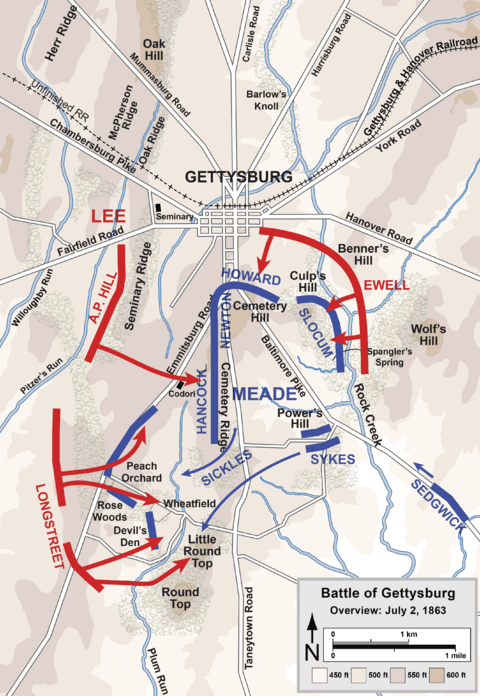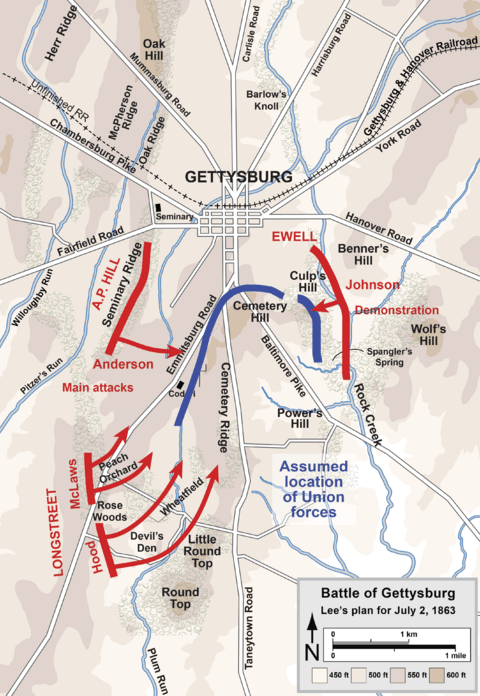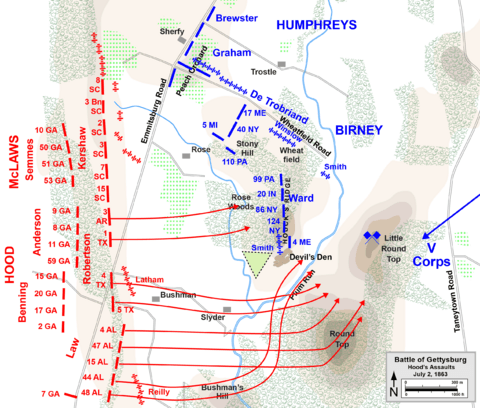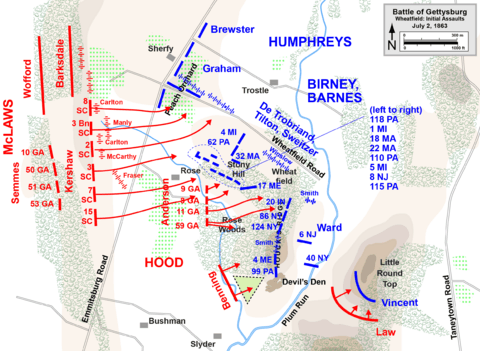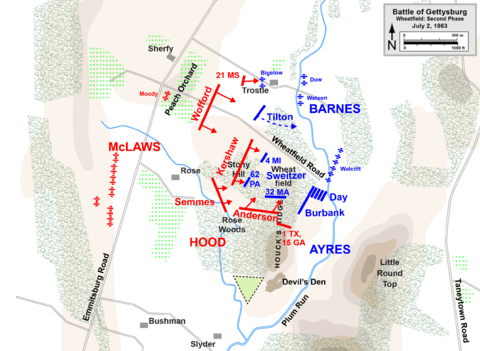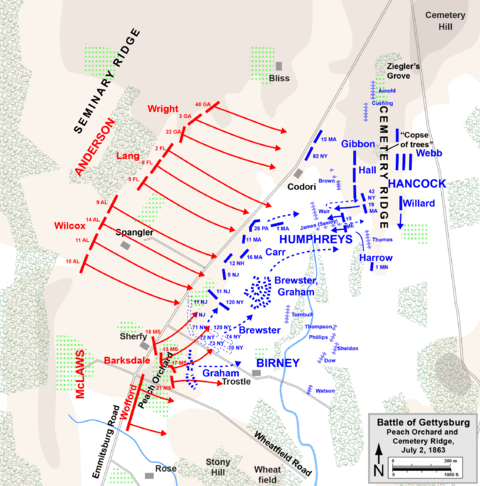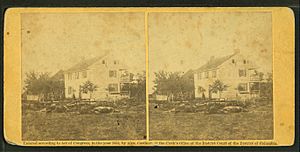Battle of Gettysburg, second day facts for kids
On the second day of the Battle of Gettysburg, July 2, 1863, Confederate General Robert E. Lee tried to build on his success from the first day. His Army of Northern Virginia launched many attacks against the sides of the Union Army of the Potomac. This army was led by Maj. Gen. George G. Meade. The attacks did not succeed and both sides lost many soldiers.
After a short delay, Confederate Lt. Gen. James Longstreet attacked the Union's left side with his First Corps. His division, led by Maj. Gen. John Bell Hood, attacked Little Round Top and Devil's Den. To Hood's left, Maj. Gen. Lafayette McLaws attacked the Wheatfield and the Peach Orchard. Even though the Confederates didn't win these spots, the Union III Corps was almost completely destroyed. They tried to defend a very wide area. Gen. Meade quickly sent about 20,000 extra soldiers from other parts of his line to help stop these strong attacks. The fighting in this area ended with an unsuccessful attack by the Confederate Third Corps division, led by Maj. Gen. Richard H. Anderson, against the Union center on Cemetery Ridge.
That evening, Confederate Second Corps commander Lt. Gen. Richard S. Ewell turned his small attacks on the Union's right side into full-blown assaults. He attacked Culp's Hill and East Cemetery Hill, but both were pushed back.
The Union army had strong defensive spots, and Meade managed his troops well. Both sides suffered heavy losses, but the positions of the armies stayed mostly the same. Lee's hope of defeating the Army of the Potomac in the North was gone. However, he was not discouraged and began planning for the third day of fighting.
This article shares details about many attacks on the Union's left side (Devil's Den, the Wheatfield, and the Peach Orchard) and center (Cemetery Ridge). Other major fights from this huge second day of battle are described in separate articles:
Contents
Background
Military Situation
Opposing Forces
Union Army
Confederate Army
Lee's Plan for July 2
By the morning of July 2, most of the Union Army had arrived. They took positions shaped like a fish hook, about three miles long. This line stretched from Culp's Hill, around Cemetery Hill, and down Cemetery Ridge. The Confederate line was roughly parallel to the Union's, on Seminary Ridge. All of the Confederate Second and Third Corps were there. The First Corps was still arriving.
General Lee had to decide what to do next. His plan from the night before, for Ewell to take Culp's Hill or Cemetery Hill, didn't happen. The Union army was now in strong defensive spots. Lee's top general, Longstreet, suggested a different plan. He wanted the army to move around the Union's left side. This would force Meade to attack them on ground that favored the Confederates. Longstreet believed this was the main goal of the campaign. But Lee said no. He worried his soldiers would feel bad giving up ground they had fought for. He also felt very confident in his army after their big wins the day before and at Chancellorsville. So, Lee decided to attack on July 2.
Lee wanted to capture the high ground south of Gettysburg, especially Cemetery Hill. This hill overlooked the town, Union supply lines, and the road to Washington, D.C.. He thought attacking up the Emmitsburg Road was the best way. He wanted Longstreet's Corps to attack early in the morning, with Ewell's Corps joining in. Ewell didn't like this idea, saying his men would be sad to leave the ground they had captured. Longstreet also said his division, led by John Bell Hood, hadn't fully arrived. Lee made a compromise. Ewell would stay put and make a small attack on Culp's Hill. This would keep Union soldiers busy there so they couldn't help their left side. Longstreet would launch the main attack as soon as he was ready. Ewell's small attack would become a full assault if a good chance appeared.
Lee ordered Longstreet to make a surprise attack with two divisions. They would move along the Emmitsburg Road. Hood's division would go up the east side, and McLaws's division would go up the west side. The goal was to hit the Union Army from an angle, pushing back their left side and collapsing their lines. The Third Corps division of Richard H. Anderson would join the attack on the Union center on Cemetery Ridge later. This plan was based on wrong information. J.E.B. Stuart and his cavalry were missing, so Lee didn't fully know where the enemy was. He thought the Union army's left side was open and unprotected near the Emmitsburg Road. But by the morning of July 2, the Union line stretched along Cemetery Ridge and was protected by Little Round Top. Lee's plan was in trouble from the start. Any force attacking up the road would face two Union corps and their cannons on the ridge to their right. However, by midday, Union General Sickles would change everything.
Sickles Repositions His Troops
When General Sickles arrived with his III Corps, General Meade told him to set up on Cemetery Ridge. He was to connect with the II Corps on his right and anchor his left on Little Round Top. Sickles did this at first. But after noon, he worried about a slightly higher piece of ground about 0.7 miles in front of him. This was a peach orchard owned by the Sherfy family. He remembered a past battle where he had to give up high ground, and the enemy used it against him with deadly cannons. Without Meade's permission, Sickles moved his corps to occupy the peach orchard. This caused two big problems: his new position stuck out like a "salient," meaning it could be attacked from many sides. Also, he had to spread his two divisions over a much longer line than they could defend. Meade rode to Sickles's position and angrily explained, "General Sickles, this is neutral ground, our guns command it, as well as the enemy’s. The very reason you cannot hold it applies to them." Meade was furious about Sickles not following orders, but it was too late. The Confederate attack was about to begin.
Longstreet's Attack Delayed
Longstreet's attack was delayed for a few reasons. First, he had to wait for his last group of soldiers to arrive. Then, he had to march them on a long, winding path so Union observers on Little Round Top wouldn't see them. It was 4 p.m. by the time his two divisions reached their starting points. Then, he and his generals were surprised to find the Union III Corps right in front of them on the Emmitsburg Road. Hood argued with Longstreet that this new situation needed a different plan. He wanted to swing around Little Round Top and attack the Union Army from behind. But Longstreet refused to change Lee's orders.
Even with Sickles's unexpected position, Longstreet's attack didn't go as Lee planned. Instead of turning left for a combined attack on both sides of the Emmitsburg Road, Hood's division attacked more to the east than planned. McLaws's and Anderson's divisions attacked one group after another, in an en echelon style. They also headed more to the east than the planned northeast.
Hood's Assault
Longstreet's attack began with a 30-minute cannon barrage from 36 guns. This was very damaging to the Union soldiers in the Peach Orchard and on Houck's Ridge. Maj. Gen. John Bell Hood's division lined up in Biesecker's Woods.
At 4:30 p.m., Hood stood up in his saddle and yelled, "Fix bayonets, my brave Texans! Forward and take those heights!" It's not clear which heights he meant. His orders were to cross the Emmitsburg Road and turn left, moving north with his left side following the road. This difference became a big problem when, minutes later, Hood was hit by an artillery shell. It badly wounded his left arm and took him out of the fight. His division kept moving east, no longer under his direct control.
There were four likely reasons why the division changed direction. First, Union soldiers from the III Corps were unexpectedly in the Devil's Den area. They would threaten Hood's right side if not dealt with. Second, shots from Union sharpshooters at Slyder's farm drew the attention of Law's Brigade, pulling them to the right. Third, the ground was rough, and units naturally lost their straight lines. Finally, Hood's second-in-command, Gen. Law, didn't know he was now in charge of the division, so he couldn't control it.
The two leading brigades split their attacks into two directions. The 1st Texas and 3rd Arkansas from Robertson's brigade, and the 44th and 48th Alabama from Law's brigade, headed toward Devil's Den. Law directed the other five regiments toward the Round Tops.
Devil's Den
Devil's Den was at the far left of the Union III Corps line. It was held by Brig. Gen. J. H. Hobart Ward's large brigade. This area was the southern end of Houck's Ridge, a small hill with huge piles of boulders. The Confederates didn't attack directly through these boulders. The 3rd Arkansas and 1st Texas pushed through Rose Woods and hit Ward's line head-on. His troops hadn't had time to build defenses. For over an hour, both sides fought fiercely. In the first 30 minutes, the 20th Indiana lost more than half its men. Its colonel was killed, and its lieutenant colonel was wounded. The 86th New York also lost its commander. The commander of the 3rd Arkansas was wounded, one of 182 casualties in his regiment.
Meanwhile, two regiments from Law's brigade moved up Plum Run Valley. They threatened to go around Ward's side. Their target was the 4th Maine and 124th New York, who were protecting Captain James Smith's 4th New York Independent artillery battery. Smith's cannons were causing a lot of trouble for Law's advance. The pressure grew so strong that Ward had to call the 99th Pennsylvania from his far right to help his left. The commander of the 124th New York, Col. Augustus Van Horne Ellis, and his major, James Cromwell, decided to counterattack. They rode their horses despite soldiers telling them to lead more safely on foot. Maj. Cromwell said, "The men must see us today." They led their "Orange Blossoms" regiment down the slope of Houck's Ridge. They pushed the 1st Texas back about 200 yards. But both Colonel Ellis and Major Cromwell were shot dead as the Texans fought back with many shots. The New Yorkers retreated to where they started, with only 100 survivors from 283 men. As more soldiers from the 99th Pennsylvania arrived, Ward's brigade took back the top of the hill.
The second wave of Hood's attack came from the brigades of Henry Benning and George "Tige" Anderson. They found a gap in Birney's division line. To Ward's right, there was a large space before the brigade of Régis de Trobriand began. Anderson's line crashed into Trobriand and the gap at the southern edge of the Wheatfield. Trobriand wrote that the Confederates "converged on me like an avalanche." But his men "piled all the dead and wounded men in our front." The Union defense was strong, and Anderson's brigade pulled back. Its commander was wounded in the leg and carried away.
Two of Benning's Confederate regiments, the 2nd and 17th Georgia, moved down Plum Run Valley around Ward's side. They faced deadly fire from the 99th Pennsylvania and Hazlett's battery on Little Round Top. But they kept pushing forward. Capt. Smith's New York battery was under heavy attack from three sides. Its supporting infantry regiments were losing many men and couldn't protect it. Three 10-pound Parrott rifles were lost to the 1st Texas. These cannons were then used against Union troops the next day.
Birney quickly looked for more soldiers. He sent the 40th New York and 6th New Jersey from the Wheatfield into Plum Run Valley. Their job was to block the Confederates from reaching Ward's side. They crashed into Benning's and Law's men in rocky, broken ground. Survivors would remember this as the "Slaughter Pen." (Plum Run itself was called "Bloody Run"; Plum Run Valley was the "Valley of Death.") Col. Thomas W. Egan, leading the 40th New York, was asked by Smith to get his cannons back. The men of the "Mozart" regiment hit the 2nd and 17th Georgia regiments, with early success. As Ward's line along Houck's Ridge continued to fall apart, the 40th's position became harder to hold. However, Egan pressed his regiment forward, launching seven attacks against the Confederate positions among the boulders. As the 40th's men fell back under constant pressure, the 6th New Jersey covered their retreat and lost a third of its men.
The pressure on Ward's brigade was too much, and he had to order a retreat. Hood's division took Devil's Den and the southern part of Houck's Ridge. The main fighting then moved northwest, to Rose Woods and the Wheatfield. Meanwhile, five regiments under Evander Law attacked Little Round Top to the east. Benning's men stayed on Devil's Den for the next 22 hours, firing across the Valley of Death at Union troops on Little Round Top.
Out of 2,423 Union soldiers fighting there, 821 were killed, wounded, or missing. The 5,525 Confederates lost 1,814 men.
Little Round Top
The Confederate attacks on Little Round Top were some of the most famous of the entire Civil War. Just as the Confederates arrived, Col. Strong Vincent's brigade of the V Corps bravely defended this spot. It was the very left end of the Union line. They fought off fierce attacks up the rocky slope. The stand of the 20th Maine under Col. Joshua L. Chamberlain against the 15th Alabama is especially famous. But heroes like Strong Vincent, Patrick "Paddy" O'Rorke, and Charles E. Hazlett also became well-known for their actions there.
McLaws's Assault
Lafayette McLaws set up his division on Warfield Ridge, similar to Hood's on his right. Lee's original plan was for Hood and McLaws to attack at the same time. But Longstreet held McLaws back while Hood's attack was happening. Around 5 p.m., Longstreet saw that Hood's division was reaching its limits and that the enemy in front of them was fully busy. He ordered McLaws to send in Kershaw's brigade, with Barksdale's to follow on the left. This started the en echelon attack—one brigade after another—which continued for the rest of the afternoon. McLaws didn't like Longstreet telling his brigades what to do directly. These brigades fought in some of the bloodiest parts of the battle: the Wheatfield and the Peach Orchard.
The Wheatfield
The area called the Wheatfield had three main features, all owned by the John Rose family: the 20-acre field itself, Rose Woods next to it on the west, and a small hill called Stony Hill, also to the west. To the southeast was Houck's Ridge, and to the south was Devil's Den. The fighting here involved many confusing attacks and counterattacks over two hours by eleven brigades. This earned the field the nickname "Bloody Wheatfield."
The first fight in the Wheatfield was actually Anderson's brigade (from Hood's division) attacking the 17th Maine. This was a spillover from Hood's attack on Houck's Ridge. Even though they were under pressure and their neighboring regiments on Stony Hill were leaving, the 17th Maine held its position behind a low stone wall with help from Winslow's battery. Anderson fell back. Trobriand wrote, "I had never seen any men fight with equal obstinacy."
By 5:30 p.m., when the first of Kershaw's regiments neared the Rose farmhouse, Stony Hill had been reinforced. Kershaw's men put great pressure on the 17th Maine, but it kept holding. For some reason, however, General Barnes pulled his division back about 300 yards to the north. He did this without talking to Birney's men. Trobriand and the 17th Maine had to follow, and the Confederates took Stony Hill and poured into the Wheatfield.
Earlier that afternoon, Meade realized Sickles's mistake. He ordered Hancock to send a division from the II Corps to help the III Corps. Hancock sent the 1st Division, which arrived around 6 p.m. Three brigades moved forward. They drove the Confederates from Stony Hill and cleared the Wheatfield, pushing Kershaw's men back to the edge of Rose Woods. Both Union commanders, Zook and Cross, were badly wounded leading their brigades. Confederate Semmes was also wounded. When Cross's men ran out of ammunition, they were replaced. But by this time, the Union position in the Peach Orchard had fallen apart. Wofford's attack continued down the Wheatfield Road, taking Stony Hill and going around the Union forces in the Wheatfield. Brooke's brigade in Rose Woods had to retreat in some confusion. Sweitzer's brigade was sent in to slow the Confederate attack, and they did this well in fierce hand-to-hand combat. The Wheatfield changed hands again.
More Union troops arrived by this time. The 2nd Division of the V Corps, known as the "Regular Division," arrived at the Wheatfield. As the regulars advanced, the Confederates swarmed over Stony Hill and through Rose Woods, going around the newly arrived brigades. The regulars retreated back to the safety of Little Round Top in good order, despite losing many men and being chased by Confederates.
This final Confederate attack through the Wheatfield continued past Houck's Ridge into the Valley of Death around 7:30 p.m. The Confederate brigades were exhausted from hours of fighting in the summer heat. As they reached the northern side of Little Round Top, they were met by a counterattack from the Union V Corps. This attack drove the tired Confederates back beyond the Wheatfield to Stony Hill. Realizing his troops were too far forward and exposed, Crawford pulled the brigade back to the east edge of the Wheatfield.
The bloody Wheatfield remained quiet for the rest of the battle. But it took a heavy toll on the men who fought for it. The Confederates fought six brigades against 13 (smaller) Federal brigades. Out of 20,444 men fighting there, about 30% were casualties. Some wounded men managed to crawl to Plum Run but couldn't cross it. The river ran red with their blood. This small farm field would be remembered by soldiers as a place of unique importance in the history of war.
The Peach Orchard
While the right side of Kershaw's brigade attacked into the Wheatfield, its left side turned left to attack the Pennsylvania troops in Brig. Gen. Charles K. Graham's brigade. This was the right side of Birney's line, where 30 cannons tried to hold the area. The South Carolinians faced many shots from the Peach Orchard and cannon fire from all along the line. Suddenly, someone shouted a wrong command, and the attacking regiments turned to their right, toward the Wheatfield. This exposed their left side to the cannons. Kershaw later wrote, "Hundreds of the bravest and best men of Carolina fell, victims of this fatal blunder."
Meanwhile, the two brigades on McLaws's left—Barksdale's in front and Wofford's behind—charged directly into the Peach Orchard. This was the point of the "salient" (the part of the line that stuck out) in Sickles's line. Gen. Barksdale led the charge on horseback, his long hair flying, sword waving. Brig. Gen. Andrew A. Humphreys's division had only about 1,000 men to cover the 500 yards from the Peach Orchard northward along the Emmitsburg Road. Some were still facing south, where they had been firing on Kershaw's brigade, so they were hit on their exposed side. Barksdale's 1,600 Mississippians turned left against the side of Humphreys's division, causing their line to collapse, one regiment at a time. Graham's brigade retreated back toward Cemetery Ridge. Graham had two horses shot from under him. He was hit by a shell piece and a bullet in his upper body. He was eventually captured. Wofford's men dealt with the defenders of the orchard.
As Barksdale's men pushed toward Sickles's headquarters near the Trostle barn, the general and his staff began to move back. Then, a cannonball hit Sickles in the right leg. He was carried off on a stretcher, sitting up and smoking his cigar, trying to encourage his men. That evening his leg was removed, and he went back to Washington, D.C.. Gen. Birney took command of the III Corps, which was soon no longer able to fight effectively.
The constant infantry charges were very dangerous for the Union cannons in the orchard and on the Wheatfield Road. They were forced to pull back under pressure. The six cannons of Capt. John Bigelow's 9th Massachusetts Light Artillery "retired by prolonge." This is a rare technique where the cannon is dragged backward while firing rapidly, helped by the gun's recoil. By the time they reached the Trostle house, they were told to hold the position to cover the infantry's retreat. But they were eventually overrun by troops of the 21st Mississippi, who captured three of their guns.
Humphreys's fate was sealed when the Confederate en echelon attack continued. His front and right side began to be attacked by Richard H. Anderson's division on Cemetery Ridge.
Anderson's Assault
The next part of the en echelon attack was by Maj. Gen. Richard H. Anderson's division. He attacked starting around 6 p.m. with five brigades in a line.
The brigades of Wilcox and Lang hit the front and right side of Humphreys's line. This destroyed any chance for his division to stay on the Emmitsburg Road and completed the collapse of the III Corps. Humphrey showed great bravery during the attack, leading his men from horseback and making them keep good order during their retreat. He wrote to his wife, "Twenty times did I [bring] my men to a halt and face about ... forcing the men to it."
On Cemetery Ridge, Generals Meade and Hancock were rushing to find more soldiers. Meade had sent almost all his available troops to his left side to stop Longstreet's attack. This left the center of his line relatively weak. There were not enough infantry soldiers on Cemetery Ridge and only a few cannons, gathered from the disaster at the Peach Orchard.
The long march from Seminary Ridge had left some Southern units disorganized. Their commanders paused briefly to reorganize. Hancock led the Union II Corps brigade to meet Barksdale's brigade as it moved toward the ridge. These New Yorkers drove the Mississippians back to Emmitsburg Road. Barksdale was wounded in his left knee, then hit by a cannonball in his left foot, and finally by another bullet in his chest, knocking him off his horse. His troops had to leave him for dead on the field, and he died the next morning in a Union hospital. The Union commander Willard was also killed, and Confederate guns then drove back Willard's men.
As Hancock rode north to find more soldiers, he saw Wilcox's brigade nearing the base of the ridge. They were aiming at a gap in the Union line. The timing was critical. Hancock chose the only troops nearby, the men of the 1st Minnesota. He pointed to a Confederate flag over the advancing line and shouted to Col. William Colvill, "Advance, Colonel, and take those colors!" The 262 Minnesotans charged the Alabama brigade with bayonets. They stopped their advance but at a terrible cost—215 casualties (82%), including 40 deaths. This was one of the largest single-action losses for a regiment in the war. Despite being greatly outnumbered, the small 1st Minnesota, with help from Willard's brigade, checked Wilcox's advance, and the Alabamians had to retreat.
The third Confederate brigade, under Ambrose Wright, crushed two regiments on the Emmitsburg Road. They captured cannons from two batteries and advanced toward a gap in the Union line. For a time, the only Union soldiers in this part of the line were Gen. Meade and some of his staff. Wright's Georgia brigade may have reached the top of Cemetery Ridge and even gone beyond it. Many historians are unsure about Wright's claims in his report. If true, he would have passed the ridge and reached the Widow Leister's house before being attacked from the side and pushed back by Union reinforcements. Others believe his story is possible because he accurately described the large numbers of Union troops on the Baltimore Pike, which he wouldn't have seen if he had been stopped earlier. Also, his talks with General Lee that evening support his claim. It's possible that Lee got some false confidence from Wright about his men's ability to reach Cemetery Ridge the next day in Pickett's Charge.
Wright told Lee that it was easy to get to the top, but hard to stay there. A big reason Wright couldn't stay was his lack of support. Two brigades were on Wright's left and could have helped his success. Carnot Posey's brigade moved slowly and never crossed the Emmitsburg Road, despite Wright's protests. William Mahone's brigade strangely never moved at all. Gen. Anderson sent a messenger with orders for Mahone to advance, but Mahone refused. Part of the blame for Wright's attack failing must go to Anderson, who didn't actively direct his division in battle.
Battle of East Cemetery Hill
Lee ordered Lt. Gen. Ewell to make a small attack on the Union's right side. He started the attack at 4 p.m. with a cannon bombardment. This caused little damage to the Union lines. But the Union cannons fired back, causing deadly damage to the lower hill. Ewell's best artillery officer, 19-year-old Joseph W. Latimer, was badly wounded and died a month later. Ewell didn't launch a full infantry attack until after 7 p.m., after Anderson's attack on Cemetery Ridge had peaked. Around 8 p.m., two brigades reached the Union cannons on East Cemetery Hill, but Union reinforcements drove them from the hill.
Culp's Hill
Maj. Gen. Edward "Allegheny" Johnson's Confederate division attacked Brig. Gen. George S. Greene's XII Corps brigade. These Union soldiers were behind strong defenses on Culp's Hill. Johnson attacked without one of his brigades, as the Stonewall Brigade was busy fighting Union cavalry for control of Brinkerhoff's Ridge. The Confederates suffered many casualties. They only gained parts of the Union line that had been left empty earlier that afternoon by General Meade, who moved those soldiers to help his left side against Longstreet.
Council of War
The battlefield became quiet around 10:30 p.m., except for the cries of the wounded. Gen. Meade sent a message to General-in-Chief Henry Halleck in Washington:
The enemy attacked me about 4 p.m. this day and, after one of the severest contests of the war, was repulsed at all points. ... I shall remain in my present position to-morrow, but am not prepared to say, until better advised of the condition of the army, whether my operations will be of an offensive or defensive character.
– George G. Meade, Telegraph to Halleck, July 2, 1863
Meade made his decision late that night in a meeting with his senior officers. The officers agreed that, despite the army taking a beating, it was best to stay in their current position and wait for the enemy to attack. There was some disagreement about how long to wait if Lee chose not to attack. There is some evidence that Meade had already decided this and was using the meeting to get everyone to agree. As the meeting ended, Meade told Brig. Gen. John Gibbon, "If Lee attacks tomorrow, it will be in your front. ... he has made attacks on both our flanks and failed and if he concludes to try it again, it will be on our centre."
There was much less confidence at Confederate headquarters that night. The army had suffered a big defeat by not moving their enemy. A staff officer said that Lee was "not in good humor over the miscarriage of his plans and his orders." But in Lee's report, he showed more hope:
The result of this day's operations induce the belief that, with proper concert of action, and with the increased support that the positions gained on the right would enable the artillery to render the assaulting columns, we should ultimately succeed, and it was accordingly determined to continue the attack. ... The general plan was unchanged.
– Robert E. Lee, Official Report on battle, January 1864.
Years later, Longstreet wrote that his troops on the second day had done the "best three hours' fighting done by any troops on any battle-field." That night he kept pushing for a strategic move around the Union left side. But Lee would not listen. He sent orders to Richard Ewell to "assail the enemy's right" at daylight. He also ordered Jeb Stuart (who had finally arrived that afternoon) to operate on Ewell's left and rear.
It is hard to know the exact number of casualties for the second day of Gettysburg. This is because both armies reported numbers after the whole battle, not by day. One estimate is that the Confederates lost about 6,000 killed, missing, or wounded from Hood's, McLaws's, and Anderson's divisions. This was 30–40% of their men. Union casualties in these actions likely were more than 9,000. One historian estimates the day's total (including the Culp's and Cemetery Hill fights) as 10,000 Union and 6,800 Confederate casualties. This is compared to about 9,000 Union and 6,000 Confederate casualties on the first day. Some estimates for the total casualties for the day go as high as 20,000. They call it the bloodiest day of the Battle of Gettysburg. It shows how fierce the fighting was that day, even though most of it happened late in the afternoon and lasted about six hours. For comparison, the Battle of Antietam—known as the bloodiest single day in American military history with nearly 23,000 casualties—was a fight that lasted twelve hours, about twice as long.
By the night of July 2, all the remaining parts of both armies had arrived. This included Stuart's cavalry and Pickett's division for the Confederates, and John Sedgwick's Union VI Corps. The stage was set for the bloody final day of the three-day battle.


